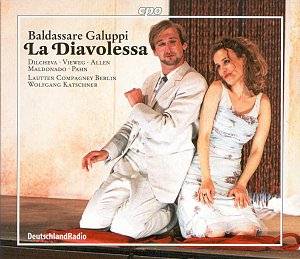For quite a number
of people Galuppi will be most familiar,
not for his music, but for Robert Browning’s
poem ‘A Toccata of Galuppi’s’. In fact
Galuppi started out as a keyboard player
and arranger of Neapolitan opera buffa.
He then went on to write opera seria,
a form in which he was very successful.
But in the 1740s he began to experiment,
unsuccessfully, with opera buffa. Then
in 1749 he produced an opera buffa to
a libretto by the dramatist Goldoni.
Both men would continue to write other
types of drama; Goldoni pursued a successful
career as a dramatist and Galuppi wrote
further opera seria. But their collaboration
on opera buffa was a notable one; they
would write a total of 17 operas together.
Goldoni would play a significant role
in the widening and development of the
form; his libretti provided Galuppi
with a wide range of subjects, arias
in a variety of metres, ensembles and
grand finales. Galuppi’s settings give
a significant prominence to the libretto,
his arias rely less on virtuosity than
those in opera seria; characterisation
becomes more important. Galuppi was
particularly good at seizing the opportunities
that Goldoni provided in his finales;
for the operas Galuppi would create
a series of multi-part finales, each
finale a chain of contrasting short
sections, each one building on the rest.
It was a model that was widely imitated
by Haydn and Mozart.
But, like many innovators,
the Galuppi-Goldoni operas have been
eclipsed by the operas of those who
built on their developments. So this
recording of Galuppi and Goldoni’s 13th
collaboration is most welcome. ‘La Diavolessa’
was first performed in 1755 in Venice
at a theatre renowned for its spoken
drama. The plot revolves around a pair
of lovers Dorina (Kremena Dilcheva,
alto) and Giannino (Matthias Vieweg,
baritone). They are unable to marry
and have run away, but are now running
out of money and Dorina threatens to
leave. Giannino is hoping for his father’s
speedy demise in order to inherit some
money. They are living at a hotel in
Naples run by Falco (Tom Allen, tenor).
Falco, charmed by Dorina suggests that
they try and dupe Don Poppone (Egbert
Junghanns, bass), who has spent years
trying to excavate a treasure. Falco
plans to present Dorina and Giannino
as experts.
Count Nastri (Johnny
Maldondo, alto) and his wife (Bettina
Pahn, soprano) also arrive at the hotel;
the count is also charmed by Dorina
and his wife threatens to leave. But
they are invited as guests at Don Poppone’s.
The Don is not happy about the Count’s
visit as it gets in the way of his treasure
hunting. The Don takes Giannino and
Dorina to be the Count and Countess
and then presumes that the Count and
Countess are the so-called experts.
The resulting confusions are played
out over the remaining acts.
The opera is prefixed
buy a short sinfonia, which is played
engagingly by the orchestra. The arias
are lively with some charming melodic
ideas and with lucid accompaniments.
The orchestral ritornello are often
imaginatively scored and the orchestra
of the Lauten Compagney relish their
opportunities. But Galuppi’s music seems
to remain constantly at the service
of the text and the drama; I never really
felt that it took wing and became truly
memorable in its own right. The most
notable section is the Act 2 finale,
where Giannino and Dorina are disguised
as devils and participate in the raising
of the ‘treasure’; here Galuppi has
produced some ‘fantastic’ music which
chimes in with the drama but which creates
its own momentum as well.
The recording seems
to have been made after a series of
staged performances; the booklet is
copiously illustrated with production
photos. As a result, the cast are all
comfortable with the drama and project
Goldoni’s text in a credible and dramatic
fashion. This is the sort of opera which
benefits immeasurably from being sung
in the audience’s language and I would
love to hear a good English version;
but for an international audience this
original language performance is highly
creditable. All the singers are securely
within their roles and make the most
of Galuppi’s pretty arias, with their
dance-like rhythms.
Dilcheva and Vieweg
are charming as the scheming pair which
is a pleasure as the entire plot revolves
around their ability to charm themselves
out of their situations. The Count and
Countess have slightly more serious
roles and Pahn sings the Countess with
an attractive bright soprano voice.
The role of the Count was intended to
be sung by a woman as a breeches role,
but here it is played by counter-tenor
Johnny Maldondo. His arias are some
of the most serious in the opera and
I felt that Maldondo did not do them
justice. Though not as virtuoso as his
opera seria, the music does require
some virtuosity. Here Dilcheva and Pahn
rather let the recording down as their
fioriture is a little smudged. But Tom
Allen, as the inn-keeper Falco, and
Doerthe Maria Sandmann, as Don Poppone’s
housekeeper, both provide notable coloratura
in the context of some fine characterisation.
The allocation of voice types is interesting
as it does not quite conform to later
practices with the major roles going
to tenor and soprano and the alto and
baritone being more supporting characters.
This is a creditable
performance, well paced by Wolfgang
Lautner. If not quite perfect, it well
enables us to appreciate the strengths
(and weaknesses) of Galuppi and Goldoni’s
opera, and to allow us to learn more
about one of the 18th century’s
notable collaborations.
Robert Hugill


